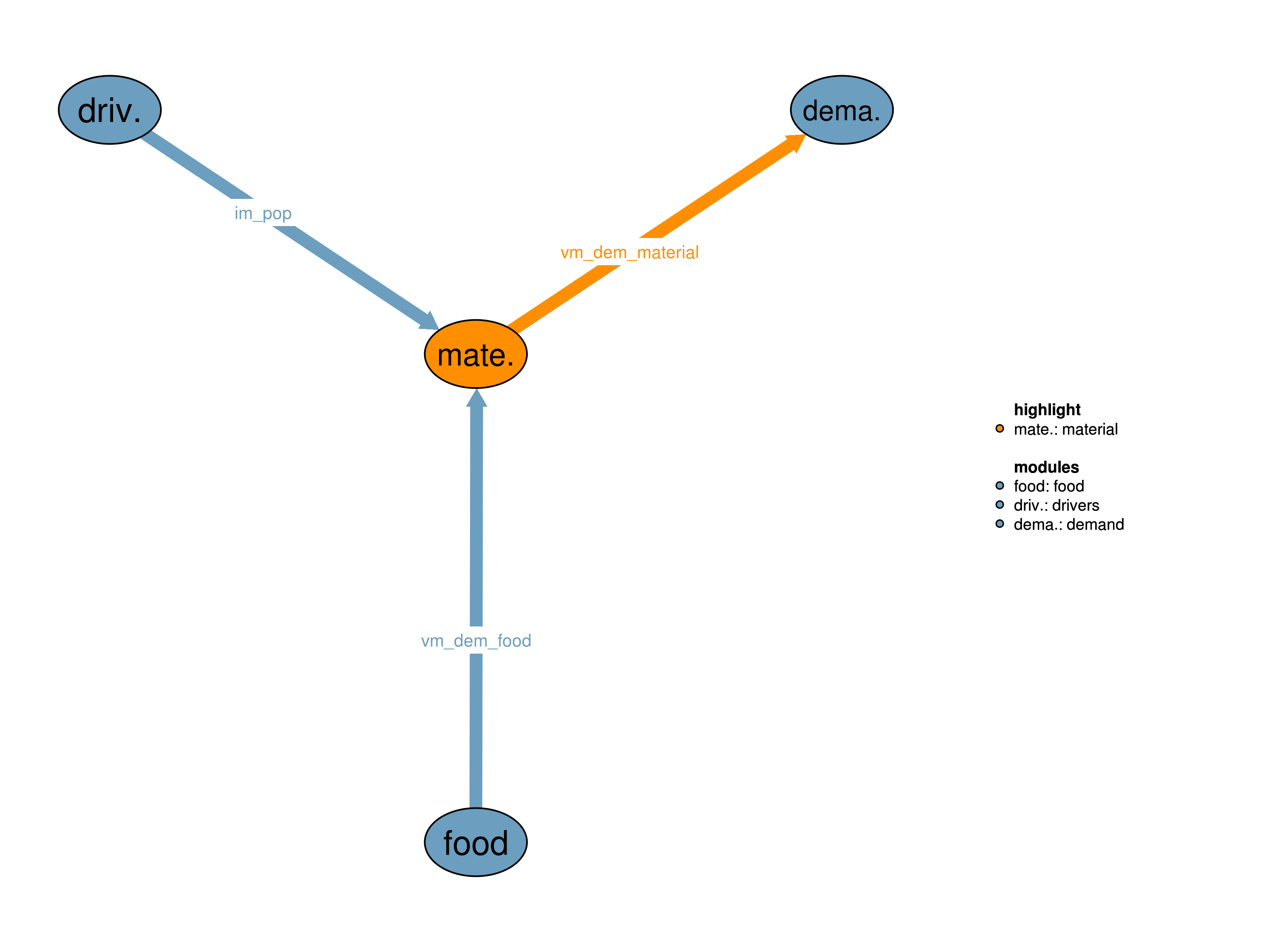The material module describes the demand for material usage based on historical data. Material uage is derived from FAO’s “other utils” category, and includes for example the use of agricultural products for cosmetics, chemical usage or textiles. In contrast to FAO’s other util category, the use for bioenergy (oils and ethanol) has been excluded and is accounted for in the demand for bioenergy. Material demand in this context can be considered as a subset of “other utils” category of FAO. In addition, increasing material demand for bioplastic production can be included by setting a target bioplastic demand.

| Description | Unit | A | |
|---|---|---|---|
| im_pop (t_all, i) |
Population | \(10^6/yr\) | x |
| vm_dem_food (i, kall) |
Food demand | \(10^6 tDM/yr\) | x |
| Description | Unit | |
|---|---|---|
| vm_dem_material (i, kall) |
Demand for material usage | \(10^6 tDM/yr\) |
In the exo_flexreg_apr16 realisation, demand for material usage is estimated to grow proportional to food demand calculated by vm_dem_food interface in food module(15_food). Observed material demand is fed as an input to the material module based on historical data. The assumption that material demand grows proportional to food demand is a simplification that can be justified by the minor importance of non-bioenergy material usage of agricultural products. In addition, biomass demand for bioplastic production is included, with future bioplastic production kept constant or following a logistic curve if a bioplastic production target is exogenously set.
Estimation of material demand depends on the value set by switch s62_historical. When it is set to 1, the material demand is estimated purely based on the historical material demand as reported by FAO. When s62_historical is switched to 0, the Material demand is calculated as the scaled version of material demand in last historical timestep depending on a scaling factor. This scaling factor is calculated as the ratio beween the food demand from last timestep and the food demand from the last historical time step. If an exogenous target for bioplastic production is set, increasing material demand (substrate) for bioplastic production is included. For historic years it is assumed that this demand is already part of the general material demand, therefore the double-counted demand is subtracted.
\[\begin{multline*} vm\_dem\_material(i2,kall) = \sum_{ct}f62\_dem\_material(ct,i2,kall) \cdot s62\_historical + \left(p62\_dem\_material\_lastcalibyear(i2,kall) \cdot p62\_scaling\_factor(i2)\right) \cdot \left(1-s62\_historical\right) + \sum_{ct}\left( p62\_bioplastic\_substrate\left(ct, i2, kall\right)\right) - \sum_{ct} p62\_bioplastic\_substrate\_double\_counted(ct,i2,kall) \end{multline*}\]
For the time period beloning to the historical time period (y1965 to y2010 in this version of the model), the scalar s62_historical is set to 1 and for the non-historical time periods, s62_historical is set to 0. How this switch affects the material demand calculations is explained in the equation(s) accompanying this module.
if (sum(sameas(t_past,t),1) = 1,
s62_historical=1;
else
s62_historical=0;
);
p62_scaling_factor(i) = 1;
p62_scaling_factor(i)$(p62_dem_food_lastcalibyear(i) > 0) = sum(kfo, vm_dem_food.l(i,kfo)) / p62_dem_food_lastcalibyear(i);The parameters p62_dem_material_lastcalibyear and p62_dem_food_lastcalibyear are overwritten based on each time step optimization, in order to be used in next step. This is only carried out when the model is still running in the time period before (and including) y2010 with this model version.
if (sum(sameas(t_past,t),1) = 1,
p62_dem_material_lastcalibyear(i,kall) = f62_dem_material(t,i,kall);
p62_dem_food_lastcalibyear(i) = sum(kfo, vm_dem_food.l(i,kfo));
);Limitations There are no known limitations.
| Description | Unit | A | |
|---|---|---|---|
| f62_biomass2bioplastic_conversion_ratio (kall) |
Biomass demand for one unit of bioplastics | \(tDM biomass/tDM bioplastic\) | x |
| f62_dem_material (t_all, i, kall) |
Historical material demand | \(10^6 tDM\) | x |
| f62_hist_dem_bioplastic (t_all) |
Historic demand for bioplastics | \(10^6 tDM\) | x |
| p62_bioplastic_substrate (t, i, kall) |
Regional biomass needed as substrate for bioplastic production | \(10^6 tDM/yr\) | x |
| p62_bioplastic_substrate_double_counted (t, i, kall) |
Bioplastic substrate counted both in general material demand and demand for bioplastic | \(10^6 tDM/yr\) | x |
| p62_bioplastic_substrate_lastcalibyear (i, kall) |
Bioplastic substrate in last historical timestep | \(10^6 tDM/yr\) | x |
| p62_dem_bioplastic (t, i) |
Demand for bioplastic | \(10^6 t/yr\) | x |
| p62_dem_food_lastcalibyear (i) |
Food demand in last historical timestep | \(10^6 tDM/yr\) | x |
| p62_dem_material_lastcalibyear (i, kall) |
Material demand in last historical timestep | \(10^6 tDM/yr\) | x |
| p62_scaling_factor (i) |
Scaling factor for material demand | \(1\) | x |
| q62_dem_material (i, kall) |
Estimating material demand | \(10^6 tDM/yr\) | x |
| s62_growth_rate_bioplastic | Logistic growth rate of bioplastic demand | \(1\) | x |
| s62_historical | Switch for turning off historical material demand | \(1\) | x |
| s62_max_dem_bioplastic | maximum demand for bioplastics | \(10^6 tDM/yr\) | x |
| s62_midpoint_dem_bioplastic | midpoint of logistic function for bioplastic demand | \(yr\) | x |
| description | |
|---|---|
| ct(t) | Current time period |
| i | all economic regions |
| i2(i) | World regions (dynamic set) |
| kall | All products in the sectoral version |
| kfo(kall) | All products in the sectoral version |
| material_scen62 | scenarios |
| t_all(t_ext) | 5-year time periods |
| t_past(t_all) | Timesteps with observed data |
| t(t_all) | Simulated time periods |
| type | GAMS variable attribute used for the output |
Benjamin Bodirsky, Debbora Leip
09_drivers, 15_food, 16_demand